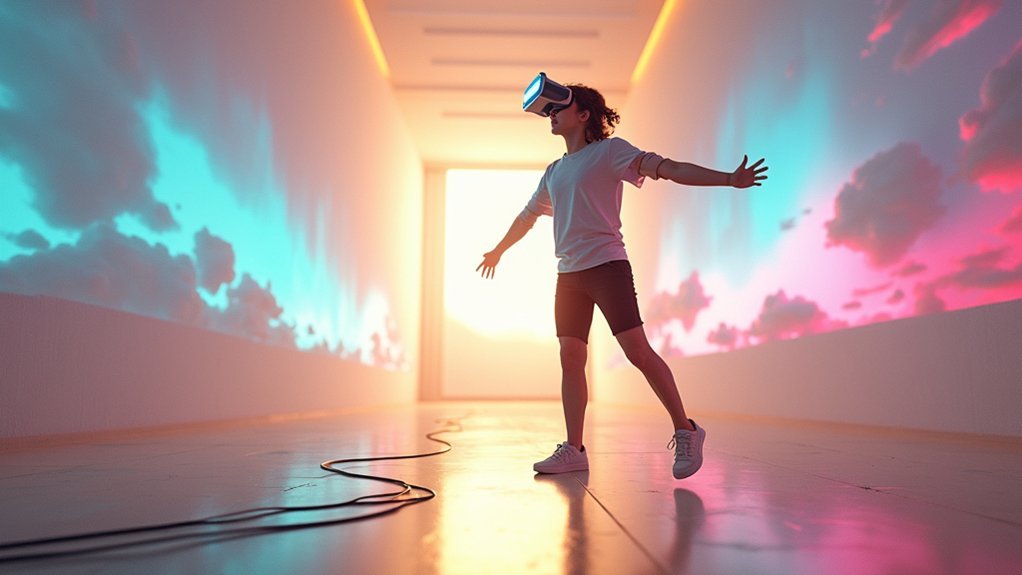You’ll experience true VR freedom when you choose untethered headsets that eliminate cable constraints and PC dependencies entirely. Unlike wireless VR that still requires expensive gaming PCs and complex Wi-Fi setups, standalone devices integrate all processing power internally, offering complete mobility for under $500. You can set up instantly anywhere without sensors or cable management, enjoying 2-6 hours of uninterrupted gameplay with fast-charging technology and access to thousands of optimized titles across gaming, education, and entertainment platforms.
What Makes VR Truly Untethered?

Why settle for VR experiences tethered by cables when you can break free entirely? Untethered VR headsets like the Meta Quest 2 deliver complete independence by housing all processing power internally. You won’t need external hardware or complicated PC connections that limit your movement and break immersion.
Experience complete VR freedom without cables, external hardware, or PC connections that restrict your movement and break immersion.
What sets wireless VR apart is its inside-out tracking technology. This eliminates bulky external sensors while maintaining precise motion detection. You’ll experience seamless tracking without sacrificing accuracy or responsiveness.
The self-contained design means simplified setup – no cable management or room configuration headaches. You’re free to move naturally in your space without tripping hazards or range limitations.
This untethered approach transforms VR from a stationary experience into truly mobile entertainment, letting you game anywhere with complete freedom of movement.
Breaking Free From Cable Constraints
While traditional VR systems chain you to a PC with thick cables, untethered VR headsets cut those digital shackles entirely.
You’ll experience true freedom of movement without worrying about tripping hazards or cable entanglement during active gameplay sessions.
These wireless systems pack everything you need directly into the headset – processing power, battery, and sensors work together for seamless operation.
You can spin, duck, and leap without calculating cable length or safe zones around your play area.
The safety benefits are immediate and obvious.
No more twisted ankles from cable snags or damaged equipment from sudden yanks.
Your 2-3 hour battery life provides uninterrupted sessions, while advancing wireless technology continues improving data transmission and reducing latency for increasingly complex VR experiences.
Wireless vs. Untethered: Understanding the Key Differences

You’ll encounter two distinct approaches to cable-free VR that fundamentally differ in how they operate.
Wireless VR maintains a connection to your gaming PC through Wi-Fi, while untethered VR processes everything directly within the headset itself.
Understanding these connection methods, processing sources, and hardware dependencies will help you choose the right freedom level for your VR experience.
Connection Method Differences
Although both wireless and untethered VR headsets free you from physical cables, they achieve this liberation through fundamentally different approaches.
Wireless VR maintains a connection to your gaming PC through Wi-Fi networks, streaming content from external hardware to your headset. You’ll need high-bandwidth routers with Wi-Fi 6 or 6E capabilities to guarantee low-latency performance. This setup requires constant communication between your headset and PC for processing power.
Untethered VR takes a completely different route. These standalone headsets operate independently with built-in processing capabilities, eliminating any need for external connections. You won’t require dedicated networks, gaming PCs, or streaming infrastructure.
Everything runs locally on the device itself, giving you true independence. This fundamental difference affects everything from setup complexity to performance capabilities and overall user experience.
Processing Power Sources
The source of processing power creates the most significant distinction between wireless and untethered VR systems.
When you choose wireless VR, you’ll need a high-performance gaming PC to handle all the heavy computational work, requiring investments between $1,500 to $3,000 for suitable hardware. Your headset fundamentally becomes a display that streams content from your PC over Wi-Fi.
Untethered VR takes a completely different approach.
These headsets, like the Meta Quest, pack all their processing capabilities directly into the device itself. You won’t need any external computer or additional hardware investments. The built-in processors are specifically optimized for VR applications, creating a streamlined experience that’s tailored for standalone operation without the complexity of maintaining wireless connections.
Hardware Dependency Levels
When examining hardware dependency, wireless VR creates a complex ecosystem that demands multiple components working in harmony.
You’ll need a high-performance gaming PC costing $1,500-$3,000, plus dedicated Wi-Fi infrastructure with specialized routers supporting Wi-Fi 6 or 6E technology. This setup requires careful configuration to guarantee network stability and low latency for smooth streaming.
Untethered VR headsets eliminate these dependencies entirely.
You won’t need external PCs, specialized routers, or complex network configurations. These devices process everything internally, typically costing under $500 for complete systems like the Meta Quest. You can start using them immediately without worrying about PC compatibility or network requirements.
While wireless setups offer processing power advantages, untethered VR headsets deliver true independence from external hardware dependencies.
The Hidden Costs of Tethered VR Systems

Beyond the advertised price of tethered VR headsets lies a web of additional expenses that can triple your initial investment. You’ll need a powerful gaming PC costing $1,500 to $3,000, plus dedicated Wi-Fi infrastructure and potential IT support for troubleshooting complex installations.
| Cost Category | Tethered VR | Untethered |
|---|---|---|
| Gaming PC Required | $1,500-$3,000 | $0 |
| Setup Complexity | High (IT support needed) | Minimal |
| Long-term Maintenance | Hardware upgrades required | Headset-only updates |
The physical cables create safety hazards, increasing accident risks during immersive experiences. While tethered systems deliver superior graphics, they limit your mobility and cause discomfort during extended use. Long-term costs accumulate through necessary hardware upgrades and maintenance, whereas untethered systems typically require only your initial headset purchase.
How Standalone Headsets Transform User Experience
Standalone headsets eliminate these financial barriers and technical hurdles by integrating all necessary processing power directly into the device.
By housing all computing components internally, standalone VR headsets remove cost barriers and complexity that previously limited widespread adoption.
You’ll discover that these self-contained units revolutionize how you interact with virtual worlds, delivering immersive experiences without complicated setup requirements.
The transformation becomes apparent through several key advantages:
- Instant setup – You’re experiencing VR within minutes, not hours of configuration
- Complete mobility – You move freely without cable constraints or tripping hazards
- Wireless connectivity – You stream content seamlessly while maintaining full interaction capabilities
Your comfort during extended sessions improves dramatically with lightweight designs optimized for prolonged use.
Whether you’re gaming, training, or socializing in virtual environments, standalone headsets provide the freedom to fully engage without technical limitations holding you back.
Battery Life vs. Unlimited Power: The Trade-Off
While standalone headsets deliver unprecedented freedom of movement, they introduce a fundamental compromise between portability and power duration. You’ll find that wireless VR headsets like the Oculus Quest 2 typically provide 2-3 hours of battery life, considerably limiting extended gaming sessions compared to wired alternatives.
| Feature | Wireless VR | Wired VR |
|---|---|---|
| Power Duration | 2-3 hours | Unlimited |
| Mobility | Complete freedom | Restricted by cable |
| Battery Management | Required | None needed |
| Session Length | Limited by charge | Unrestricted |
High-resolution displays and demanding applications drain batteries rapidly in untethered VR. However, you can extend playtime with swappable batteries found in models like the VIVE Focus 3. This trade-off defines modern VR: unlimited power versus unrestricted movement.
Graphics Performance: Standalone vs. PC-Powered VR
Two distinct approaches to VR graphics performance create vastly different visual experiences depending on your hardware choice.
When you choose standalone VR, you’re trading graphical fidelity for portability. These headsets run optimized software that guarantees smooth performance for less demanding applications, but you’ll notice limitations in visual quality compared to their tethered counterparts.
PC-powered VR leverages your computer’s powerful hardware to deliver advanced graphics rendering. You’ll experience:
- High-resolution textures and detailed environments
- Complex visual effects and lighting
- Graphically intensive titles like “Half-Life: Alyx”
Your choice ultimately depends on priorities. Standalone VR offers untethered freedom with acceptable graphics for most experiences.
PC-powered VR delivers stunning visual fidelity that creates deeper immersion, though you’ll sacrifice mobility for superior graphical performance.
Inside-Out Tracking Revolutionizes Movement Freedom
You’ll experience true VR freedom with inside-out tracking technology that eliminates the hassle of setting up external sensors around your play space.
Your headset’s built-in cameras and sensors handle all the position tracking, so you won’t need to mount cameras on walls or worry about complex calibration procedures.
This breakthrough transforms room-scale gaming by letting you move naturally through your entire space without tripping over cables or losing tracking accuracy.
Eliminates External Sensor Setup
Because inside-out tracking technology enables your VR headset’s cameras to monitor your position in real-time, you’re finally free from the tedious setup process that plagued earlier VR systems.
You no longer need to spend precious time configuring and positioning external sensors or base stations around your room.
Untethered VR with inside-out tracking delivers immediate access to immersive experiences through:
- Plug-and-play simplicity – No external equipment installation required
- Instant room-scale tracking – Your headset maps the environment automatically
- Zero calibration hassles – Advanced algorithms handle spatial recognition seamlessly
This streamlined approach transforms how you engage with virtual reality.
Instead of wrestling with complicated hardware configurations, you simply put on your headset and dive straight into your virtual adventures.
The technology handles all the complex tracking work behind the scenes.
Enhanced Room-Scale Gaming
Six degrees of freedom transform your gaming experience from a stationary observer into an active participant who can duck, dodge, weave, and explore every corner of virtual worlds.
Untethered VR headsets like the Meta Quest 2 deliver this revolutionary movement capability through inside-out tracking technology that precisely maps your environment in real-time.
You’ll enjoy enhanced room-scale gaming that responds instantly to your body movements, whether you’re crouching behind cover or reaching for virtual objects.
The system adapts seamlessly to different room sizes and layouts, letting you set up immersive experiences anywhere.
Without external sensors cluttering your space, you’re free to move dynamically during intense gaming sessions while maintaining accurate tracking throughout your play area.
Setup Simplicity: Plug and Play VR
Why should setting up VR feel like assembling a space station when it could be as simple as putting on a pair of headphones?
Untethered VR eliminates the complexity that’s plagued traditional VR systems for years. You won’t need to connect cables, configure external sensors, or worry about PC compatibility issues.
Wireless VR headsets free you from the tangled mess of cables and complicated setup procedures that make traditional systems feel like rocket science.
Here’s what makes standalone VR setup incredibly straightforward:
- Instant startup – Your headset without wires boots up in minutes with intuitive guided configuration
- No external hardware required – Built-in processing power means you’re not tethered to expensive gaming PCs
- Immediate access – Over 1,000 titles available right out of the box
You’ll spend more time exploring virtual worlds and less time troubleshooting technical problems. The plug-and-play nature means you can focus on what matters most: experiencing VR.
Content Libraries: What’s Available for Untethered Devices
What good is a sleek, untethered headset if there’s nothing compelling to experience on it?
You’ll find content libraries for untethered devices are surprisingly robust. The Meta Quest 2 launched with over 1,000 titles, spanning action, adventure, and educational experiences.
While standalone headsets typically feature simpler content than PC VR, they’re designed for broader accessibility with less demanding games and 360° movies.
Platforms like Oculus Store and VIVEPORT offer extensive VR libraries specifically optimized for untethered devices. You can even connect some headsets to PCs, accessing high-end titles like Half-Life: Alyx.
Free offerings include immersive experiences from BBC VR, Jurassic World, and CNN VR, giving you varied entertainment without additional costs.
These libraries guarantee you’ll have compelling content from day one.
The Future of Portable Virtual Reality
You’re witnessing a revolution in portable VR that’s reshaping how we experience virtual worlds.
Standalone headsets are becoming more powerful while batteries extend far beyond today’s 2-3 hour limits, giving you unprecedented freedom to explore without wires or external hardware.
This hardware evolution is driving explosive growth in VR content ecosystems, creating richer libraries specifically designed for untethered experiences.
Standalone Hardware Advances
While traditional VR systems tether you to expensive gaming PCs, standalone VR headsets like the Meta Quest 2 have revolutionized portable virtual reality by integrating all necessary hardware—processor, battery, and sensors—into a single, wireless device.
These advances make VR more accessible than ever:
- Built-in processing power handles high-quality graphics for gaming and training applications without external computers.
- Inside-out tracking technology eliminates external sensors, enabling complete freedom of movement through headset-based tracking.
- Improved battery life delivers 2-3 hours of continuous use, supporting extended VR sessions.
You’ll find these devices cost under $500, dramatically reducing the financial barrier compared to high-end wired systems requiring expensive gaming rigs.
This hardware integration transforms VR from a stationary experience into truly portable entertainment you can enjoy anywhere.
Battery Technology Evolution
As portable VR headsets become more powerful, battery technology emerges as the critical bottleneck determining how long you can stay immersed in virtual worlds. Current standalone headsets deliver 2-3 hours of playtime, but manufacturers are pushing boundaries with innovative solutions.
| Feature | Current Tech | Emerging Solutions | Future Promise |
|---|---|---|---|
| Battery Life | 2-3 hours | Swappable designs | 6+ hours |
| Charging Speed | 1-2 hours | Fast-charging tech | 15-30 minutes |
| Battery Type | Lithium-ion | Enhanced Li-ion | Solid-state |
Swappable battery designs in headsets like the VIVE Focus 3 let you swap depleted batteries instantly. Meanwhile, solid-state batteries promise higher energy density and safety for untethered VR. Fast-charging developments aim to minimize downtime, making extended virtual experiences truly accessible.
Content Ecosystem Growth
Beyond hardware improvements, the content ecosystem for portable VR has exploded into a thriving marketplace that transforms how you experience virtual worlds.
You’ll find over 1,000 titles available on standalone headsets like the Meta Quest 2, giving you immediate access to diverse experiences without setup hassles.
Major platforms are rapidly expanding their catalogs to meet your untethered demands:
- VIVEPORT and Steam – Broadening VR libraries with gaming, education, and entertainment content
- Optimized standalone software – Developers creating experiences that maximize performance without external hardware
- Cross-platform compatibility – Future headsets may access PC VR content seamlessly
Market projections confirm you’re part of a growing movement toward portable VR solutions.
As developers focus on untethered optimization, you’ll enjoy richer experiences with enhanced performance and unprecedented freedom.
Frequently Asked Questions
What Is the Difference Between Tethered and Untethered VR Headsets?
You’ll find tethered VR headsets require physical connections to computers, limiting your movement, while untethered headsets operate independently with built-in processors and batteries, giving you complete freedom to move around without restrictions.
What Does Standalone VR Mean?
Standalone VR means you’re using a self-contained headset that doesn’t need a PC or external devices. You’ll get complete virtual reality experiences with built-in processing, storage, and battery all in one device.
Can You Use a VR Headset on Its Own?
Yes, you can use standalone VR headsets completely on their own. You don’t need a PC or phone – they’ve got built-in processors, storage, and batteries, so you’ll experience full VR independently.
Why Does VR Require so Much Power?
VR demands massive power because you’re running high-resolution displays, complex graphics rendering, and real-time tracking systems simultaneously. Your headset’s processors work overtime creating immersive environments, quickly draining batteries during intensive applications.





Leave a Reply